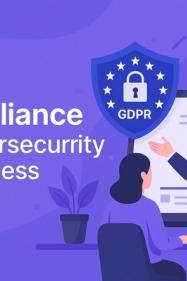SOC 2 Type II has become the gold standard for demonstrating security and trustworthiness in the SaaS and technology sectors. Unlike Type I, which evaluates controls at a point in time, Type II measures how effectively those controls are operating over a defined period — typically six to 12 months.
This extended focus places greater emphasis on the human element. A well-structured Cybersecurity Awareness Training (CSAT) program is essential not only for satisfying Trust Service Criteria (TSC), but also for proving ongoing effectiveness of your internal controls — especially those related to security, confidentiality, and privacy.
SOC 2 Type II: A Quick Overview
Developed by the AICPA, SOC 2 audits evaluate how a company protects customer data using five Trust Service Criteria:
- Security (mandatory)
- Availability
- Processing Integrity
- Confidentiality
- Privacy
While only Security is required for all SOC 2 reports, the others are increasingly adopted depending on business model or client demand.
SOC 2 Type II requires you to implement and operate controls continuously, with documentation and evidence collected over time.
Where Cybersecurity Awareness Training Fits
SOC 2 doesn’t dictate how to run a training program, but it does require that you prove your employees understand and adhere to security policies.
Awareness training directly supports:
- Common Criteria 2.2 (CC2.2): Control activities to mitigate risk must be implemented — including policies and procedures.
- Common Criteria 4.2 (CC4.2): Employees should be trained to perform roles in accordance with security policies.
- Privacy Criteria (PI and P4): For companies opting into the Privacy TSC, ongoing employee education is mandatory.
Why Human Risk Matters in SOC 2 Type II
SOC 2 is built around internal controls, and many common risks originate with people:
- Employees falling for phishing or vishing attacks
- Improper handling of confidential customer data
- Misuse of privileged credentials
- Failure to report suspicious activity
In a Type II audit, an isolated incident — even a single phishing click — can raise red flags if it points to ineffective controls over time.
This makes Cybersecurity Awareness Training not just a best practice, but a core compliance requirement.
Real-World Simulations for SOC 2 Risk Scenarios
Our platform delivers realistic, AI-driven simulations that allow organizations to train, test, and measure employee behavior across real-world threat vectors.
Phishing Simulation
Spear-phishing targeting credentials, invoices, customer data access — tailored to your environment.
Smishing Simulation
SMS-based impersonation of clients, leadership, or IT support — testing mobile channel awareness.
Vishing Simulation
Social engineering via voice: fake tech support, executive spoofing, compliance fraud. Each simulation supports role-based deployment, so developers, support, sales, and leadership can be trained with relevant content.
How Our Platform Supports SOC 2 Compliance
To meet SOC 2 Type II expectations, you must operationalize your controls. Our platform helps you:
- Automate regular training across departments and roles
- Maintain audit-ready training logs with timestamps and outcomes
- Generate control evidence for auditors (e.g., CC2.2, CC4.2)
- Measure and track security culture maturity
You can demonstrate control effectiveness across the entire audit window, with dashboards and reports tailored to GRC leaders and auditors.
Designing a CSAT Program for SOC 2 Type II
To align with SOC 2 expectations, your training program should:
1. Be Continuous and Measurable
Auditors will ask how often training is conducted and how performance is tracked.
2. Address High-Risk Roles and Scenarios
Focus on departments with access to client data, production systems, and customer support portals.
3. Include Simulation-Based Testing
Demonstrate that training results in behavioral change — not just policy acceptance.
4. Be Fully Documented
Use our platform’s reporting features to show date-stamped evidence of completion, remediation steps, and scenario types.
Preparing for a SOC 2 Type II Audit
Auditors will likely request:
- Evidence of training completion
- Examples of awareness materials
- Proof of ongoing training over the audit period
- Documentation showing how training maps to internal risks
By using our platform, GRC teams can export full audit packages in just a few clicks — significantly reducing the prep burden.
Benefits Beyond Compliance
A strong CSAT program also improves real-world outcomes:
- Reduced phishing-related incidents
- Faster incident detection through employee reporting
- Lower risk of confidential data leakage
- Enhanced customer trust during procurement processes
For many SaaS companies, passing SOC 2 is a revenue enabler — but robust training ensures those controls actually protect your business.
Preparing your CSAT for SOC2 Type II prepares you for other certifications such as HIPAA.
Why Leading SaaS Companies Choose Our Platform
Our platform is purpose-built for regulated, fast-moving tech environments. Key capabilities include:
- 🎯 Role-based simulations aligned with SOC 2 risks
- 📈 Metrics dashboards for CISOs, GRC managers, and HR
- 🧾 Audit-ready reporting (mapped to Trust Service Criteria)
- 🌐 Multilingual support for global teams
- 🔄 Automated refreshers and just-in-time training
Whether you're pre-audit or mid-cycle, we help SaaS and tech companies stay compliant, secure, and agile.
Conclusion: Turn Training Into a Competitive Advantage
SOC 2 Type II isn’t just a checkbox — it’s a reflection of your ability to manage trust. That trust is often broken not by malware, but by a well-meaning employee clicking the wrong link.
With effective Cybersecurity Awareness Training in place, you strengthen your internal controls, reduce breach risk, and give your audit process the transparency it demands.
Request a Demo
Discover how our AI-powered Awareness Training platform helps SaaS companies maintain SOC 2 Type II compliance — with measurable results, audit-ready reports, and enterprise-grade threat simulations. 👉 Request a Demo Now

